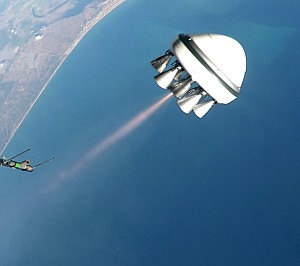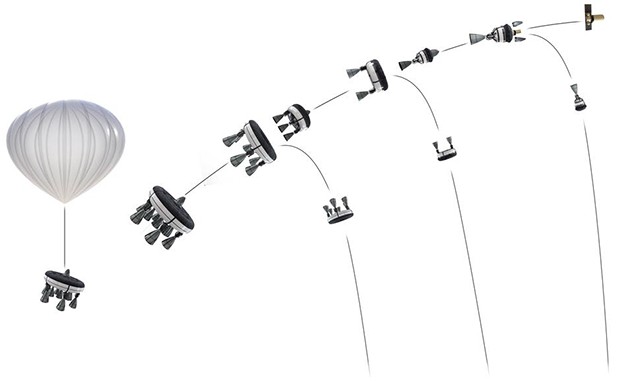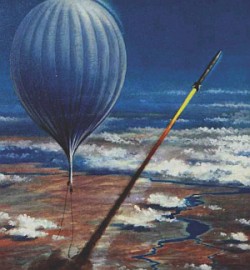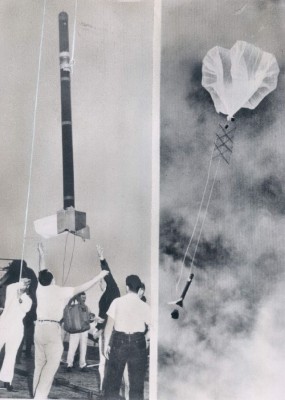News Archive
-
March, 13 2017
Zero2Infinity, Bloostar and the return of the "Rockoons"

Gulf of Cádiz, Spain.- The people of Zero2Infinity continue to make small but steady steps in their stratospheric adventure, and this time they have grabbed the headlines of the aerospace digital media around the world after completing the launch of their "Bloostar" rocket from a stratospheric balloon to 26 Kilometers of altitude.
The test took place on March 1st, in front of the Atlantic coast of Andalucia within the airspace controlled by El Arenosillo Experimentation Center (CEDEA) operated by INTA, the Spanish space agency.
Bloostar, is a launch vehicle based on a hybrid system called "Rockoon" (contraction of the English terms "Rocket" and "Balloon") on which the first stage of the ascent is carried out using a stratospheric balloon that transports the vehicle up to 30 km. Once there the rocket ignites and detaches itself from the balloon to insert the payload into orbit. The thrust is given by a set of liquid fuel engines grouped as concentric reusable toroids attached to the central payload. Each toroid acts as a stage during the rise of the rocket, separating progressively from the vehicle and then being recovered on Earth, similar to what happens with a conventional satellite launch, as we can see in the scheme below.

The balloon departed from the deck of a ship sailing in the Gulf of Cadiz, approximately at 15:00 utc, rising to 26 km altitude for approximately 70 minutes, reaching the coordinates 36º 50 'North 6º 56' West. Once there, at 16:15 utc a brief countdown of ten seconds began, during which the launching system that served to connect the rocket to the balloon proceeded to orient it in direction SSE towards open sea and launched it..
The objectives of the mission were: The goals of the mission were: (i) , (ii) , (iii) , (iv) monitoring of the launch sequence, (v) parachute deployment, and finally, (vi) sea recovery.
- the validation of the telemetry systems in space conditions,
- to test the controlled ignition,
- to perform the stabilization of the rocket,
- a full monitoring of the launch sequence,
- to perform a correct parachute deployment, and
- to recover the prototype from the sea.
Although more details of the test have not been released, according to the press release published by the company, the objectives were fully achieved.
Under these lines we can see a brief video showing just the culminating moments of the ascent and the moment of the rocket ignition. The images are of such clarity that they allow to appreciate details of the coast as for example the white sands of the Natural Park of Doñana or the city of Cadiz.
While the approach chosen by Zero2Infinity is original in the context of nowadays initiatives to reach the space, the concept of using a balloon as a virtual "first stage" of a rocket was born almost seven decades ago.
A little bit of history

As I've said at the beginning, Rockoons have a long history, and that story is associated with the giant figure of Dr. James Van Allen, who was the first to use a balloon to lift a rocket into the stratosphere and launch it from there.
The idea was sketched by Lieutenant (US Navy) Morton Lee Lewis -who would then participate in the Stratolab manned balloon program- during an Aerobee rocket firing campaign that took place in March 1949 aboard the U.S.S. Norton Sound.
The rudimentary of these launches, in which the rocket hung from the balloon by a nylon rope and had no mechanism to guide its initial course, forced -due to safety reasons- to launch them from unpopulated areas.
Thus during the early 1950's dozens of missions were carried out using as launching pad the icebreaker vessels which the US Coast Guard used to replenish the scientific and military bases in the Arctic. Missions were also carried out from equatorial latitudes, in Antarctica and off the west coast of the United States.

The first "Rockoons" fired by Van Allen used a single Deacon or Loki vector. Subsequent experiments used a combination of both to form a two stage rocket and a third version called "Hawk" used an improved Loki vector.
However, the most sophisticated version of a rockoon would be used ephemerally in the year 1957 for the Farside project.
When the United States still did not get out of its shock from the launch of Sputnik, and its own rocket launch technology failed to advance, Farside sought to transport a very small payload into extraterrestrial space, using a four-stage rocket.
The project was carried out by the Office of Scientific Research of the Air Force, using various instruments provided by the University of Maryland. A total of six rockets were built by Aeronutronic Systems, Inc. and a complex pointing system was developed by General Mills so that the vector could ascend vertically through the balloon.
The balloons were launched from Enewetak, an atoll of the Marshall Islands located in the Pacific Ocean. A total of six tests were carried out between September and October 1957, of which only the fifth succeeded.
Under these lines we have a short video taken from a newsreel of those times showing that flight.
Returning to the central theme of the article, as expected the entire Zero2Infinity team met in their offices in mid-March, to celebrate the event, which included a nice "Bloostar Cake" specially cooked for the occasion.
The test of the rocket -of which I do not have more data in terms of size- comes just under two months after another important milestone: the launch test of a real-size capsule of their BLOON system intended to carry passengers to near space.
The flight took place on January 23 from the facilities of the Lérida-Alguaire airport in Catalonia, and consisted in the test of preparation, inflation and release of a stratospheric balloon which remained ththered to the aforementioned capsule. The maneuver served as a full rehearsal for a future flight mission.
Under these lines a video summary of the test.
Undoubtedly, Zero2Infinity is steadily consolidating itself with small but steady steps towards its goal and that in itself is very commendable, especially in a sector of the aerospace industry so prone to the spectacular headlines, and that sometimes seems to be guided more by the needs of marketing than by real technological advances.
-
Share this on social media


